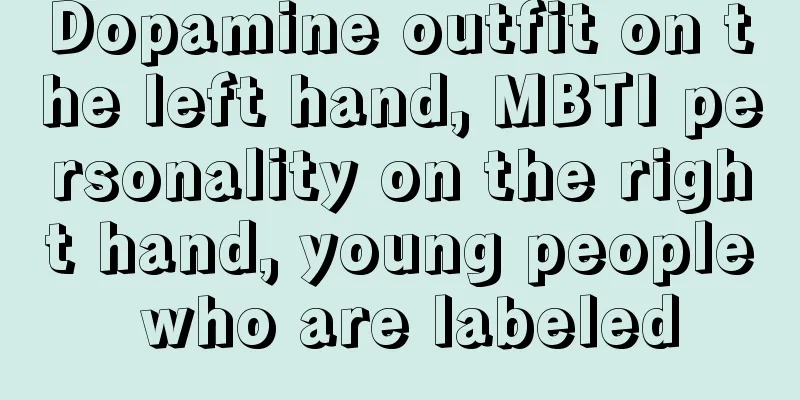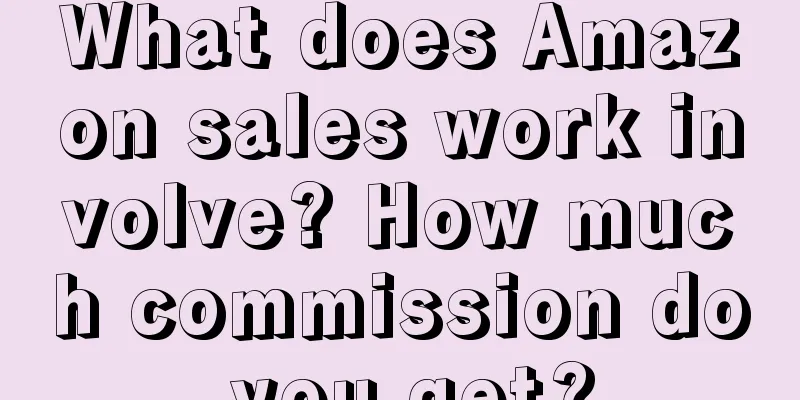Dopamine outfit on the left hand, MBTI personality on the right hand, young people who are labeled

You may not be familiar with the above lyrics, but if you use it together with the picture below, do you feel that a melody is pushing into your head? △The picture comes from the Douyin account @Kangye1937 You may not be clear about MBTI, but if I ask you whether you are an E person or an I person, can you suddenly find the organization? "Dopamine Dressing" and "MBTI" are the two most popular online labels nowadays. Under the bombardment of various online social platforms, countless young people have surrendered and joined the army of labeling. But when two labels that seem to have nothing to do with each other appear in the same article at the same time, are you starting to suspect that the editor is trying to make up the word count? In today's world of universal creation, users are not only users of tags, but also creators of tags. When the colorful "dopamine outfit" meets the colorful "MBTI personality", users begin to use different labels in combination in order to better present their own personality in the online society, and even create a new "label package", organically combining the two most popular labels through a "guess MBTI from the picture" activity. 1. From dopamine outfits to dopamine everything, the growth of a labelAs long as you are a trendsetter on the Internet, it is probably difficult to escape the sniping of "dopamine dressing". But do you really know "dopamine dressing"? Let’s do a test first. Which of the following pictures shows “dopamine outfit”? △The pictures are all from Xiaohongshu users, see the information on the picture for details The answer is the first picture. The next two pictures show the Harajuku style and Y2K style outfits respectively. They all love to use colorful items and pay attention to the matching of accessories, so what is the difference between "dopamine dressing" and other styles? This starts from the source. In 2020, Dawn Karen, a professor of fashion psychology at the Fashion Institute of Technology in New York, first proposed in her book Dress Your Best Life that, based on the influence of color on emotions, wearing brightly colored clothes can stimulate the release of dopamine, bringing people happy, positive and positive emotions, and thus defined "Dopamine Dressing", which is what we now know as "dopamine dressing". Therefore, rather than saying that "dopamine dressing" is a style, it is better to say that it is a color matching idea, which mainly uses colors to express happy emotions. Riding on the momentum of social media, fashion blogger "Daytime Bear" officially ignited the popularity of "dopamine dressing" in China, and with a shopping-style "dopamine dressing" video, he set off a trend of imitation by the whole nation. At this point, the label of "dopamine dressing" officially appeared and became a popular label that netizens rushed to claim. △Xiaohongshu up master TJandClaire and pet up master Jin Sangui also joined the "Dopamine Wear" team △Hospitals can also have a lot of dosing! Source: see the information on the picture But the "dopamine" trend has not only spread to the fashion industry. Content producers who have smelled the secret of traffic have quickly developed labels such as "dopamine literature" and "dopamine circle of friends", vowing to spread dopamine to all aspects of life. △"Dopamine" + "money-making" have firmly grasped the lifeline of young people who love fashion and money. "Dopamine Dressing" has established a discourse context with the slogan "Create happiness, express happiness" . The followers use the label as a symbol to express their identity; the traffic grabbers accurately grasp the desire of people for happiness in today's society and create a larger collection of "dopamine" labels. In this era of barrier-free information flow, the borderless open state allows people to achieve a high degree of aggregation or rapid dispersion through tags in the virtual world. Traffic has also become a monetization chip that content creators, merchants and even users are madly scrambling for. Those competing for traffic will not be limited to the label of "dopamine dressing". What they want to do is to find another way to let more people be labeled and respond to this "happy" carnival. 2. MBTI: Not related at all, but definitely tied togetherThe trend of "dopamine XX" has not yet passed, but the trend of MBTI has already started to blow again. The Myers-Briggs Type Indicator (MBTI) is a personality test scale compiled by American writer Isabel Myers based on the research of her mother Katharine Cook Briggs. It is a development and application of the "psychological type theory" of Swiss psychologist Jung. This test first entered the market in the United States just after the end of World War II (yes, it is such a long-standing test that has captured you). Later, under Isabel's active operation, MBTI became one of the best-selling products in the psychological assessment market. After entering the Internet age, MBTI has set off a wave of testing crazes on the Internet every once in a while. "What is your MBTI?" has become a necessary part of greetings among contemporary young people. △Source: see the information on the picture MBTI will classify people into 16 types based on their answers to questions. Each type contains four letters, and each letter represents a personality trait, such as E for extroversion and I for introversion. This is also the origin of E people and I people. So how is "MBTI" related to "dopamine dressing"? "Guess MBTI from the picture" is a challenge activity started by Xiaohongshu users. It has received more than seven million views so far. Among them, "dopamine dressing" is an indispensable element of posting. When massive amounts of information are freely disseminated in front of users, users not only become recipients of labels, but also actively begin to interact with labels, promoting the evolution, development and dissemination of labels, gradually expanding the audience range of labels, and triggering greater social impact. In line with the emphasis on color in "dopamine dressing", "MBTI" also uses color to classify personality, with purple representing "rationalism", green representing "idealism", blue representing "protectiveism", and yellow representing "optimism". Therefore, "MBTI" and "dopamine dressing" have natural similarities. It is not difficult to understand why Xiaohongshu users would "match" these two labels. 3. Inescapable Internet labels, you and I are both playersIn the Internet age, we are all "the labeled generation." With the fragmentation of social life, labels have become a magic weapon for this generation of young people to show themselves to the world and quickly find allies. In his book The Presentation of Self in Everyday Life, sociologist Goffman proposed the "Theory of Dramatism", arguing that everyone is a performer in daily interactions and life. "Dopamine Wear" and "MBTI" are the images that people present to others and society on stage. We have no way of knowing whether the real life behind each E-person is so vibrant through the screen. But what we see on stage is that each E-person recognizes each other under their tweets and shares their outgoing daily life. The choice of labels will also affect people’s actual behavior. In order to maintain their “personality” on stage, people need to manage their self-image, ensuring that their words, expressions, movements, behaviors, and even the clothes, accessories, home furnishings, and other items they buy are consistent with their “personality” and consolidate others’ specific views of themselves. The trends and characteristics of social group behavior are also irritating merchants. Merchants who have noticed this trend have also begun to combine "dopamine" with "MBTI" personality, trying to apply "drama theory" to practice, allowing users' obsession with personal personality to penetrate reason, strengthen their own impression of the "should behavior" of their personality, and make every consumption a part of individual impression management. IV. ConclusionWhy do we actively practice "dopamine dressing"? Because we don’t want to fall behind, we must take advantage of the opportunity to show our positive and sunny side. Why do we label ourselves with “MBTI” personality? Because we need to better deconstruct and explain ourselves and gain more recognition and emotional support. Are you, who are surfing the Internet, also constrained by the need for personal performance and putting labels on yourself? Author: Meng Meng; Editor: Shi Guang; Editor: Bandao Source public account: Cultural Industry Review (ID: whcypl), China’s top new media for cultural industry. |
<<: Pay for knowledge, and end the relationship as soon as the deal is completed!
Recommend
Is the fate of workers in the hands of AI interviewers?
AI interviews are becoming a new trend in recruitm...
I'll be frank: China's marketing has changed dramatically
The failure of traditional brand marketing has bec...
How many main pictures can an eBay product have? Are there any requirements?
Nowadays, many people choose cross-border e-commer...
What should I pay attention to when using Amazon Japan? How can I open an Amazon Japan site?
As one of the world's largest e-commerce platf...
How long will it take for an Amazon account to be closed? How much can it be sold for?
On Amazon, if you have your own account, you can b...
Xiao Yangge disappears, Li Jiaqi says "difficult", top anchors 618 life
This year's 618, the atmosphere of the promoti...
What kind of logistics does Allegro platform provide? Is Allegro platform easy to operate?
For many people, Allegro is one of the largest onl...
How to open a cross-border e-commerce store? What is the process?
Today, I will introduce you to the content of open...
Is it necessary to choose a brand when selling goods on Shopee? How to operate Shopee?
Shopee is currently the largest cross-border e-com...
The lie of Occam's razor
The principle of Occam's razor is often simpli...
How to advertise on Wish? What is the method?
As one of the cross-border e-commerce platforms, W...
What are Amazon's main product strategies? How to promote them?
Everyone should know about the Amazon platform. No...
Where to find growth in 2023? 丨Douyin VS Kuaishou Advertising
Amidst the pressure and uncertainty, "tighten...
5 safe and reliable ways to attract traffic from Xiaohongshu
As a content-driven social platform, Xiaohongshu p...
Do shein's suppliers make money? What are the requirements for shein suppliers?
Shein has a large number of suppliers around the w...









